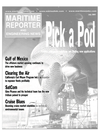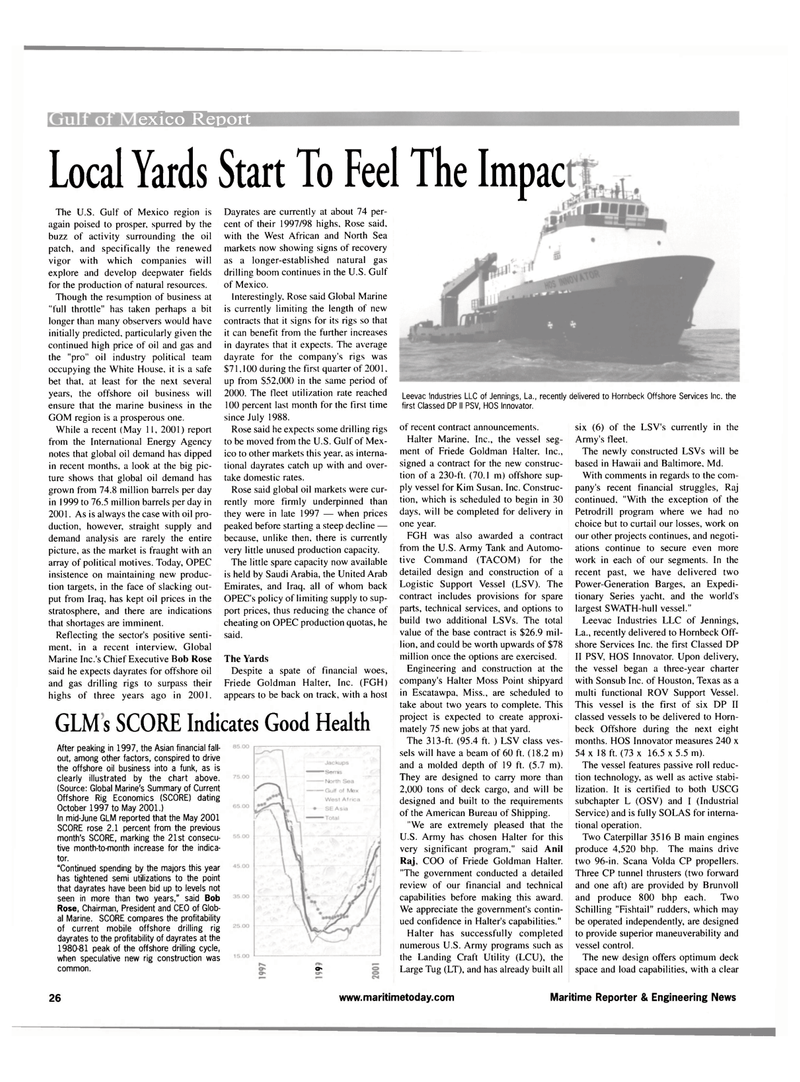
Page 26: of Maritime Reporter Magazine (July 2001)
Read this page in Pdf, Flash or Html5 edition of July 2001 Maritime Reporter Magazine
exico Report
Local Yards Start To Feel The Impac
The U.S. Gulf of Mexico region is again poised to prosper, spurred by the buzz of activity surrounding the oil patch, and specifically the renewed vigor with which companies will explore and develop deepwater fields for the production of natural resources.
Though the resumption of business at "full throttle" has taken perhaps a bit longer than many observers would have initially predicted, particularly given the continued high price of oil and gas and the "pro" oil industry political team occupying the White House, it is a safe bet that, at least for the next several years, the offshore oil business will ensure that the marine business in the
GOM region is a prosperous one.
While a recent (May 11, 2001) report from the International Energy Agency notes that global oil demand has dipped in recent months, a look at the big pic- ture shows that global oil demand has grown from 74.8 million barrels per day in 1999 to 76.5 million barrels per day in 2001. As is always the case with oil pro- duction, however, straight supply and demand analysis are rarely the entire picture, as the market is fraught with an array of political motives. Today, OPEC insistence on maintaining new produc- tion targets, in the face of slacking out- put from Iraq, has kept oil prices in the stratosphere, and there are indications that shortages are imminent.
Reflecting the sector's positive senti- ment, in a recent interview, Global
Marine Inc.'s Chief Executive Bob Rose said he expects dayrates for offshore oil and gas drilling rigs to surpass their highs of three years ago in 2001.
Dayrates are currently at about 74 per- cent of their 1997/98 highs, Rose said, with the West African and North Sea markets now showing signs of recovery as a longer-established natural gas drilling boom continues in the U.S. Gulf of Mexico.
Interestingly. Rose said Global Marine is currently limiting the length of new contracts that it signs for its rigs so that it can benefit from the further increases in dayrates that it expects. The average dayrate for the company's rigs was $71,100 during the first quarter of 2001. up from $52,000 in the same period of 2000. The fleet utilization rate reached 100 percent last month for the first time since July 1988.
Rose said he expects some drilling rigs to be moved from the U.S. Gulf of Mex- ico to other markets this year, as interna- tional dayrates catch up with and over- take domestic rates.
Rose said global oil markets were cur- rently more firmly underpinned than they were in late 1997 — when prices peaked before starting a steep decline — because, unlike then, there is currently very little unused production capacity.
The little spare capacity now available is held by Saudi Arabia, the United Arab
Emirates, and Iraq, all of whom back
OPEC's policy of limiting supply to sup- port prices, thus reducing the chance of cheating on OPEC production quotas, he said.
The Yards
Despite a spate of financial woes,
Friede Goldman Halter, Inc. (FGH) appears to be back on track, with a host
GLMs SCORE Indicates Good Health
After peaking in 1997, the Asian financial fall- out, among other factors, conspired to drive the offshore oil business into a funk, as is clearly illustrated by the chart above. (Source: Global Marine's Summary of Current
Offshore Rig Economics (SCORE) dating
October 1997 to May 2001.)
In mid-June GLM reported that the May 2001
SCORE rose 2.1 percent from the previous month's SCORE, marking the 21st consecu- tive month-to-month increase for the indica- tor. "Continued spending by the majors this year has tightened semi utilizations to the point that dayrates have been bid up to levels not seen in more than two years," said Bob
Rose, Chairman, President and CEO of Glob- al Marine. SCORE compares the profitability of current mobile offshore drilling rig dayrates to the profitability of dayrates at the 1980-81 peak of the offshore drilling cycle, when speculative new rig construction was common.
Leevac Industries LLC of Jennings, La., recently delivered to Hornbeck Offshore Services Inc. the first Classed DP II PSV, H0S Innovator. o» of recent contract announcements.
Halter Marine. Inc., the vessel seg- ment of Friede Goldman Halter, Inc., signed a contract for the new construc- tion of a 230-ft. (70.1 m) offshore sup- ply vessel for Kim Susan, Inc. Construc- tion, which is scheduled to begin in 30 days, will be completed for delivery in one year.
FGH was also awarded a contract from the U.S. Army Tank and Automo- tive Command (TACOM) for the detailed design and construction of a
Logistic Support Vessel (LSV). The contract includes provisions for spare parts, technical services, and options to build two additional LSVs. The total value of the base contract is $26.9 mil- lion, and could be worth upwards of $78 million once the options are exercised.
Engineering and construction at the company's Halter Moss Point shipyard in Escatawpa, Miss., are scheduled to take about two years to complete. This project is expected to create approxi- mately 75 new jobs at that yard.
The 313-ft. (95.4 ft. ) LSV class ves- sels will have a beam of 60 ft. (18.2 m) and a molded depth of 19 ft. (5.7 m).
They are designed to carry more than 2,000 tons of deck cargo, and will be designed and built to the requirements of the American Bureau of Shipping. "We are extremely pleased that the
U.S. Army has chosen Halter for this very significant program," said Anil
Raj, COO of Friede Goldman Halter. "The government conducted a detailed review of our financial and technical capabilities before making this award.
We appreciate the government's contin- ued confidence in Halter's capabilities."
Halter has successfully completed numerous U.S. Army programs such as the Landing Craft Utility (LCU), the
Large Tug (LT), and has already built all six (6) of the LSV's currently in the
Army's fleet.
The newly constructed LSVs will be based in Hawaii and Baltimore, Md.
With comments in regards to the com- pany's recent financial struggles, Raj continued, "With the exception of the
Petrodrill program where we had no choice but to curtail our losses, work on our other projects continues, and negoti- ations continue to secure even more work in each of our segments. In the recent past, we have delivered two
Power-Generation Barges, an Expedi- tionary Series yacht, and the world's largest SWATH-hull vessel."
Leevac Industries LLC of Jennings,
La., recently delivered to Hornbeck Off- shore Services Inc. the first Classed DP
II PSV, HOS Innovator. Upon delivery, the vessel began a three-year charter with Sonsub Inc. of Houston, Texas as a multi functional ROV Support Vessel.
This vessel is the first of six DP II classed vessels to be delivered to Horn- beck Offshore during the next eight months. HOS Innovator measures 240 x 54 x 18 ft. (73 x 16.5 x 5.5 m).
The vessel features passive roll reduc- tion technology, as well as active stabi- lization. It is certified to both USCG subchapter L (OSV) and I (Industrial
Service) and is fully SOLAS for interna- tional operation.
Two Caterpillar 3516 B main engines produce 4,520 bhp. The mains drive two 96-in. Scana Volda CP propellers.
Three CP tunnel thrusters (two forward and one aft) are provided by Brunvoll and produce 800 bhp each. Two
Schilling "Fishtail" rudders, which may be operated independently, are designed to provide superior maneuverability and vessel control.
The new design offers optimum deck space and load capabilities, with a clear 26 www.maritimetoday.com Maritime Reporter & Engineering News

 25
25

 27
27
